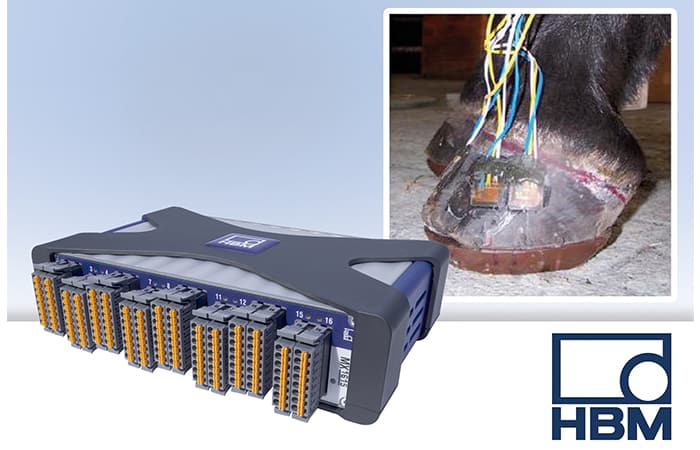
When Myerscough College in Lancashire recently conducted a study to explore the future management of Equine laminitis, one of the most common causes of lameness in horses and ponies in the UK, HBM – a market leader in the field of test and measurement - was able to provide a reliable data measurement solution.
As part of its continued research into evaluating compression strain under different therapeutic shoeing scenarios, the aim of the study was to provide veterinary surgeons and farriers with a clearer understanding of the principal strain within a diseased hoof, in order to reach a better understanding of the management of the disease.
Following a successful bid for a grant to purchase a complete measuring chain from HBM, which comprised of a 16 channel carrier-frequency Quantum MX1615 and 1-RV91-3-120 strain gauges, Myerscough College was able to collect numerical and categorical evidence on the deformation system of the hoof capsule using specific therapeutic shoeing techniques as part of its research.
As part of its study, five encapsulated prewired rosette strain gauges were attached to the dorsal, medial and lateral aspects of the foot and three variables were manipulated: barefoot, with the attachment of a steward clog and the combination of a steward clog and Equitech hoof cast. The equine was walked on a firm tarmac surface and each pass was considered acceptable when the equine achieved a natural rhythm of a walk with the head and the neck aligned with the body. The equine was first lead in a straight line for 20m, then in to a 10m diameter circle on the left reign. A semicircle was then marked out with a chalk line, and the equine walked a further 20m in a straight line. This was counted as one pass and two passes were performed with each variable.
Results were then fed to the HBM 16 channel carrier-frequency Quantum MX1615. The appropriate gauge factors were entered into the corresponding channels within the computer software and signals were checked to ensure correct connection. Calculation of channels was set up related to the input channels to record principal stress one, principal stress two and principal stress for each rosette, resulting in 30 channels in total. In addition, visualisation screens were also set up to display strain levels and principal stress values and angles for each rosette. Data recording was then set up at 600 Hz across all channels. To determine accuracy, all channels were zeroed with the leg in an unloaded position, prior to each test. Data was then saved for each test run in a separate file for later evaluation.
Data was then recorded in Microsoft Excel 2010™ over two complete passes in three directions for each of the three treatments, barefoot, with the Steward clog and then with the application of hoof cast at the stance phase. Five complete stance phases were randomly selected from each of the directions and from each treatment, and data was then recorded in units of micro strain and microseconds at four points identified on the Catman data image, which were impact, mid stance, heel off and end of stance phase.
The results collated from this study confirmed that strain gauge experimental stress analysis Quantum MX1615 is capable of collecting and analysing the hoof wall deformation system under different parameters. Furthermore, the study also showed that the overall strain and patterns of the dorsal hoof capsules deformation system could be collected with this system and that individual peaks of strain magnitude could be evaluated between barefoot, clog, hoof cast and direction.
Over the years, various methods of farriery treatment have been used to relieve biomechanical symptoms, all with varying levels of success. Traditionally based upon anecdotal experience, this study provided actual quantitative evidence and it is this understanding that will facilitate farriers in the further management of laminitis.










Water Sector Talent Exodus Could Cripple The Sector
Maybe if things are essential for the running of a country and we want to pay a fair price we should be running these utilities on a not for profit...